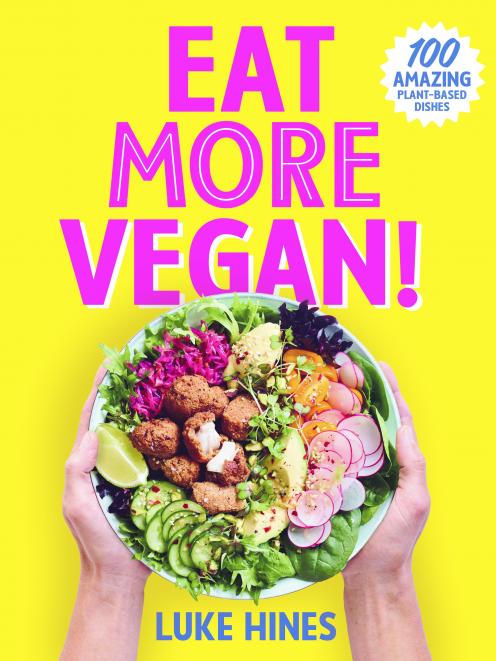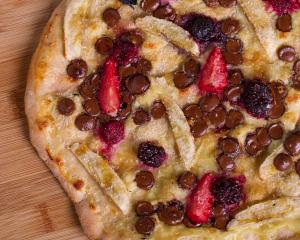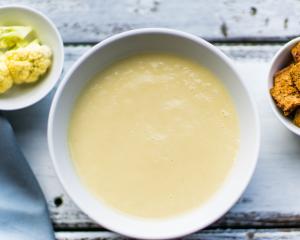
The driving force behind his latest book Eat More Vegan is to get people to eat more plants and in turn improve their health with each mouthful, the My Kitchen Rules television show finalist says.
His recipes are gluten and grain free with an emphasis on seasonal fruits and vegetables, nuts and seeds, healthy cooking fats and oils and herbs and spices.
What is missing is legumes and pseudo grains. Hines has deliberately missed them out because of the time constraints to prepare them as they need time-consuming soaking and fermentation to ensure they do not cause digestive issues.
He ‘‘proudly’’ claims his recipes are low carb, keto friendly, paleo and gluten, dairy and refined sugar free.
‘‘You won’t find any faux versions of meats or meat replacements which can often be high in soy and inflammatory seed oils.’’
The environmental impact of how people eat is also important to him. Food security, treatment of animals, industrialised farming practices and long-term sustainability of food production are all issues to consider, he says.
His recipes are designed to be made in bulk when needed and are kept simple by featuring a few ingredients and ‘‘making them shine’’.
He promises not to have sacrificed flavour in creating his recipes and urges people to have fun with their food, listen to their bodies and ‘‘smile’’.
 Herby hasselbacks with salsa verde
Herby hasselbacks with salsa verde

These herby hasselback sweet potatoes are really delicious and easy to make, yet quite impressive. Their fanned tops get beautifully browned and crispy in the oven while the insides remain nice and soft.
I like to baste mine in a garlicky, herby salsa verde to give them lots of extra flavour.
Serves 4
Ingredients
4 small sweet potatoes (about 800g), unpeeled
3 Tbsp extra-virgin olive oil
1 tsp finely chopped fresh or dried rosemary
1 tsp finely chopped fresh or dried thyme
2 garlic cloves, very finely chopped
1 tsp chilli flakes
1 tsp lemon zest (optional)
sea salt and freshly ground black pepper
Salsa verde
1 large handful of basil leaves, plus extra to serve
1 large handful of flat-leaf parsley, stalks and leaves
¼ red onion, finely chopped
2 garlic cloves, very finely chopped
3 Tbsp extra-virgin olive, avocado, macadamia or hemp oil
zest and juice of 1 lime
Method
Preheat the oven to 180degC and line a large baking tray with baking paper.
Using a sharp knife, make deep incisions 2-3mm across each sweet potato, ensuring you don’t cut right down to the bottom so they hold together.
Place the sweet potatoes on the prepared tray, brush with 1 tablespoon of the olive oil and bake for 30 minutes.
Whisk the rosemary, thyme and garlic with the remaining 2 tablespoons of olive oil in a bowl. Set aside.
To make the salsa verde
Add all the ingredients to a food processor and blitz to form a rough paste.
Remove the sweet potatoes from the oven and spoon the herby oil over the top.
Return to the oven and bake for another 15 minutes, or until the sweet potatoes are browned on top and cooked all the way through.
To serve, divide the hasselbacks among plates and sprinkle with the chilli flakes and lemon zest, if you like. Season with salt and pepper, drizzle over the salsa verde and scatter over a few basil leaves to finish.
Tip: Ever wondered why sweet potatoes are actually sweet? Well, when you heat sweet potatoes, an enzyme starts breaking down their starch into a sugar called maltose. Maltose isn’t as sweet as table sugar and, interestingly, you can control the sweetness of sweet potatoes somewhat by how you cook them. Cooking sweet potatoes quickly, for instance, by steaming them or cutting them into smaller pieces before roasting, can reduce their ultimate sweetness.
On the other hand, cooking sweet potatoes slowly on low heat will give that maltose-making enzyme more time to convert the starch into sugar, giving you sweeter sweet potatoes. Sweet!
 Crispy eggplant katsu curry
Crispy eggplant katsu curry

With its crispy coconut coating and rich curry sauce, this vegan version of the popular Japanese dish ticks all the taste and health boxes. This recipe is inspired by childhood days spent walking past my local Japanese takeaway shop and picking up a bento box that always included katsu curry. It was by far my favourite part of the day.
Serves 4
Ingredients
2 eggplants, cut lengthways into 1cm-thick slices
2 tsp sea salt
60g (½ cup) arrowroot or tapioca flour
3 Tbsp coconut flour
1½ Tbsp ground flaxseeds
200ml filtered water
3 Tbsp coconut cream
90g (1 cup) desiccated coconut
170g (1 cup) hemp seeds
3 Tbsp sesame seeds
2 tsp garlic powder
coconut oil, for deep-frying
To serve
800g (4 cups) cauliflower rice (see below), cooked
Curry sauce
1 Tbsp coconut oil
1 small onion, finely chopped
4 garlic cloves, very finely chopped
1 Tbsp curry powder
1 Tbsp arrowroot or tapioca flour
375ml (1½ cups) vegetable stock
2 Tbsp coconut aminos or tamari
1 Tbsp apple cider vinegar
1 Tbsp maple syrup or coconut nectar
Salad
¼ small green cabbage, outer leaves discarded, finely shredded
¼ small red cabbage, outer leaves discarded, finely shredded
2 spring onions, finely sliced diagonally, plus extra to serve
1 Tbsp apple cider vinegar
1 tsp maple syrup or coconut nectar
Method
Arrange the eggplant slices on two trays in a single layer. Sprinkle over the salt and set aside for 20 minutes.
Meanwhile, make the curry sauce. Heat the coconut oil in a small saucepan over medium-high heat. Add the onion, garlic and curry powder and cook, stirring, for 3-4 minutes, or until the onion is softened.
Stir in the arrowroot or tapioca flour, then gradually pour in the stock, stirring constantly, until fully incorporated. Add the coconut aminos or tamari, vinegar and sweetener and bring to a simmer.
Cook for 5-10 minutes, stirring occasionally, until slightly thickened. Remove from the heat and leave to cool slightly, then transfer to a food processor and blitz until smooth. Set aside.
Combine the arrowroot or tapioca flour and coconut flour in a shallow bowl. In a separate bowl, whisk together the ground flaxseeds, water and coconut cream.
In a third bowl, combine the desiccated coconut, hemp seeds, sesame seeds and garlic powder and mix well.
Using paper towel, wipe the salt from the eggplant slices and pat dry. Place an eggplant slice in the flour mixture and turn to coat, shaking off the excess. Next, dip it in the flaxseed mixture and finally in the coconut and hemp seed mixture, pressing down lightly to secure the crumb. Transfer to a plate and set aside.
Repeat with the remaining eggplant slices until they are all coated.
Heat a large, heavy-based frying pan over medium heat and fill with the coconut oil to a depth of 1 cm. Heat the oil to 180°C. (To test if the oil is hot enough, simply drop a small piece of bread into it — if it sizzles and bubbles, you’re good to go.) Add half the eggplant slices and cook for 4-5 minutes on each side, or until golden. Carefully remove the eggplant and drain on paper towel. Repeat with the remaining eggplant slices.
To make the salad, add the green and red cabbage and spring onion to a bowl, drizzle over the vinegar and sweetener and toss to combine.
When ready to serve, reheat the curry sauce in a saucepan over medium heat.
Divide the salad and cauliflower rice among plates, top with the eggplant, drizzle over the warm curry sauce and sprinkle over a little extra spring onion.
 Wellness bowl
Wellness bowl

When putting this book together, the team and I wanted to showcase a variety of my recipes on the cover in a way that made your mouth water. Hence, this incredible combination of recipes from within the book has become what is now known as ‘‘the cover-worthy wellness bowl’’. It encapsulates everything I love about the food in this book — it’s fresh, easy, flavoursome, textural and delicious!
Serves 6
Ingredients
3 large handfuls of mixed lettuce leaves
2 Lebanese cucumbers, finely sliced
6 radishes, finely sliced
24 orange cherry tomatoes, halved
½ cup pink sauerkraut
1½ avocados, quartered
1 KFJ (Kentucky fried jackfruit, see below)
Dressing
3 Tbsp coconut aminos
1 garlic clove, finely grated
1cm piece of ginger, peeled and finely grated
zest and juice of 1 lemon
2 Tbsp extra-virgin olive, avocado, macadamia or hemp oil
1 Tbsp apple cider vinegar
To serve
vegan mayo
toasted sesame seeds
hemp seeds
chilli flakes
micro herbs
lime wedges
Arrange the lettuce leaves so that they cover the base and side of each serving bowl. Add the cucumber, radish, tomato, sauerkraut, avocado and Kentucky fried jackfruit.
For the dressing, place all the ingredients in a bowl and whisk well to combine. Drizzle the dressing over the salad and add a generous dollop of vegan mayo.
Sprinkle over some sesame seeds, hemp seeds, chilli flakes and micro herbs, add a lime wedge for squeezing and dig in!
You’ll see I have used the ever-versatile jackfruit in this book whenever I have needed to replicate anything fleshy and hearty (in particular, the mouthfeel and texture of chicken).
This vegan take on KFC tastes so close to the original you’ll be triple checking what ingredients you used. Fantastic for entertaining and a real crowd pleaser, I know this will become a favourite in your house.
Serves 4
Ingredients
Buttermilk
250ml (1 cup) coconut milk
1½ Tbsp apple cider vinegar
Crumb
140g arrowroot or tapioca flour
50g (½ cup) almond meal
1½ tsp sea salt
1 tsp freshly ground black pepper
1 tsp onion powder
1 tsp dried thyme
1 tsp dried oregano
1 tsp ground ginger
1 tsp smoked paprika
1 tsp garlic powder
½ tsp cayenne pepper
½ tsp chilli flakes (optional)
540g canned young jackfruit in water
coconut oil, for frying
sea salt and freshly ground black pepper
To serve
vegan mayo
Method
Combine the buttermilk ingredients in a large bowl. Set aside.
In a second large bowl, combine the crumb ingredients. Set aside.
Drain and rinse the jackfruit pieces really well. Using a sharp knife, cut off and discard any parts of the jackfruit that are hard or contain seeds (you want to try to use only the parts that are stringy or soft, as this will help to provide a similar texture to chicken).
Dip the trimmed jackfruit pieces first in the buttermilk, then in the crumb, then return to the buttermilk before finally dipping in the crumb mixture once again.
Place a large, heavy-based frying pan over medium heat and fill with coconut oil to a depth of 2½cm. Heat the oil to 180degC. (To test if the oil is hot enough, simply drop a small piece of bread into it — if it sizzles and bubbles, you’re good to go.)
Add the crumbed jackfruit in batches, being careful not to overcrowd the pan. Fry for 4-6 minutes, turning halfway through, until golden brown and crispy.
Once cooked, remove with a slotted spoon and place on paper towel to drain.
Pile the jackfruit pieces on to a platter, season well with salt and pepper and serve with the vegan mayo for dipping.












